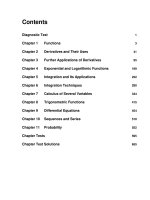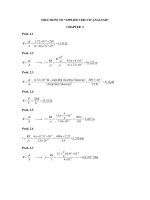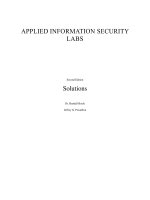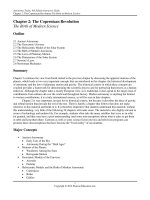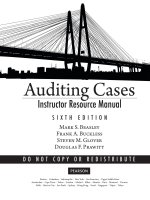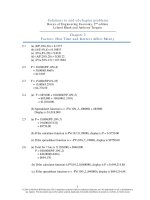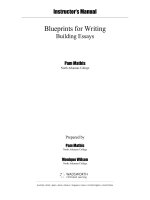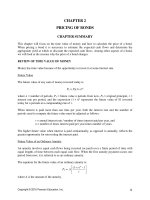Solution manual of ch2 differentiation
Bạn đang xem bản rút gọn của tài liệu. Xem và tải ngay bản đầy đủ của tài liệu tại đây (178.23 KB, 29 trang )
Chapter 2: Differentiation
1. Find the slope of the tangent line to the graph of the function below at the given point.
f ( x) 2 x –10, (3, –4)
A)
2
B)
–2
–10
C)
D) 12
E) none of the above
Ans: A
2. Find the slope of the tangent line to the graph of the function at the given point.
f ( x) –5 x 2 +10, (–2, –10)
A)
20
–5
B)
–10
C)
–20
D)
E) none of the above
Ans: A
3. Find the slope of the tangent line to the graph of the function at the given point.
f ( x) 2 x 2 + 6, (3, 24)
A) 12
B)
2
–6
C)
D) 18
E) none of the above
Ans: A
4. Use the limit definition to find the slope of the tangent line to the graph of
f ( x) 4 x 29 at the point (5, 7) .
A)
2
7
B)
2
7
C)
1
7
D)
1
7
E)
1
5
Ans: A
Larson, Calculus: An Applied Approach (+Brief), 9e
Page 59
5. Find the derivative of the following function using the limiting process.
f ( x) –2 x 2 – 9 x
A)
–2
–4 x – 9
B)
–4 x + 9
C)
–4x
D)
E) none of the above
Ans: B
6. Find the derivative of the following function using the limiting process.
f ( x) 9 x – 6
A)
9
f ( x)
2 9x – 6
B)
9
f ( x)
2 9x – 6
C)
9
1/ 2
f ( x) 9 x – 6
2
D)
9
f ( x)
9x – 6
E) either B or D
Ans: A
7. Find the derivative of the following function using the limiting process.
f ( x)
A)
B)
2
x–9
f ( x)
2
x – 9
f ( x)
2
2
x + 9
C)
f ( x)
2
x + 9
D)
f ( x)
2
x – 9
2
2
E) none of the above
Ans: D
Larson, Calculus: An Applied Approach (+Brief), 9e
Page 60
8. Find an equation of the line that is tangent to the graph of f and parallel to the given line.
f ( x) 5 x 2 , 20 x y 2 0
A)
y 20 x – 20
y 20 x + 20
B)
C)
y –20 x + 20
y –20 x – 20
D)
E)
none of the above
Ans: A
9. Find an equation of the a line that is tangent to the graph of f and parallel to the given
line.
f ( x) 5 x 3 , 135 x y 6 0
A)
y –135 x – 270
B)
y 135 x + 270
y –135 x + 270
C)
D)
y 135 x – 270
E) both B and D
Ans: E
Larson, Calculus: An Applied Approach (+Brief), 9e
Page 61
10. Identify a function f ( x) that has the given characteristics and then sketch the function.
f (0) 3; f '( x) 4, x
f ( x) 4 x 3
A)
B)
f ( x) –4 x 3
C)
f ( x) 4 x 3
Larson, Calculus: An Applied Approach (+Brief), 9e
Page 62
D)
f ( x) –4 x 3
E)
f ( x) 3x + 4
Larson, Calculus: An Applied Approach (+Brief), 9e
Page 63
Ans: A
11. Find the derivative of the function.
f ( x) x 7
A)
f ( x) 7 x 7
B)
f ( x) 7 x 6
C)
f ( x) 6 x 6
D)
f ( x) 6 x8
E) none of the above
Ans: B
12. Find the derivative of the function.
f ( x) 2 x 3 – 3x 2 +1
A)
f ( x) 6 x 2 – 6 x
B)
f ( x) 4 x 2 – 3 x
C)
f ( x) 4 x – 3 x 2
D)
f ( x) 6 x 2 – 6 x +1
E) none of the above
Ans: A
Larson, Calculus: An Applied Approach (+Brief), 9e
Page 64
13. For the function given, find f '( x).
f ( x) x 3 15 x 6
A)
x 2 15
B)
3x 2 6
C)
3x 2 15
D)
3x 3 15 x
E)
x3 15 x 6
Ans: C
14. Find the derivative of the function.
h( x) 15 x 23 11x13 4 x10 3 x 7
A)
330 x 22 132 x12 36 x 9 3
B)
345 x 23 143x13 40 x10 3x
C) 15 x 22 11x12 4 x9 3
D)
345 x 22 143x12 40 x 9 3
E)
330 x 23 132 x13 36 x10 3x
Ans: D
15. Find the derivative of the function h( x) x5/ 3 .
A)
5
h '( x) x8/ 3
3
B)
5
h '( x) x 2 / 3
3
C)
5 2/3
h '( x) x
3
D)
5
h '( x) x8 / 3
3
E)
5
h '( x) x 2 / 3
3
Ans: C
16. Find the derivative of the function s (t ) 2 x 2 8 .
A)
4
s '(t ) 3
x
B)
4
s '(t ) 3
x
C)
4
s '(t ) 3 8
x
D)
4
s '(t ) 3 8
x
E)
s '(t ) 2 x 3
Ans: B
Larson, Calculus: An Applied Approach (+Brief), 9e
Page 65
17. Find the derivative of the function.
f ( x)
A)
1
x3
2
x4
B)
3
f ( x) 2
x
C)
3
f ( x) 4
x
D)
4
f ( x) 4
x
E) none of the above
Ans: C
f ( x)
18. Differentiate the given function.
3
y 4
4x
A)
12
5
x
B)
3
4
x
C)
12
4
x
D)
3
5
x
E)
4
5
x
Ans: D
19. Differentiate the given function.
5
y
(4 x) 4
A)
80
(4 x)5
B)
20
(4 x)5
C)
80
(4 x)5
D)
20
(4 x)5
E)
20
(4 x)3
Ans: C
Larson, Calculus: An Applied Approach (+Brief), 9e
Page 66
20. Determine the point(s), (if any), at which the graph of the function has a horizontal
tangent.
y ( x) x 4 32 x 1
0
A)
B)
0 and 2
C)
0 and –2
D)
2
E) There are no points at which the graph has a horizontal tangent.
Ans: D
21. The graph shows the number of visitors V to a national park in hundreds of thousands
during a one-year period, where t = 1 represents January. Estimate the rate of change of
V over the interval 5,8 . Round your answer to the nearest hundred thousand visitors
per year.
A)
B)
C)
D)
E)
Ans:
176.92 hundred thousand visitors per year
328.57 hundred thousand visitors per year
166.67 hundred thousand visitors per year
383.33 hundred thousand visitors per year
766.67 hundred thousand visitors per year
C
22. Find the marginal cost for producing x units. (The cost is measured in dollars.)
C 205, 000 9800 x
$9800
A)
$9850
B)
$8800
C)
$8850
D)
$9750
E)
Ans: A
Larson, Calculus: An Applied Approach (+Brief), 9e
Page 67
23. Find the marginal revenue for producing x units. (The revenue is measured in dollars.)
R 50 x 0.5 x 2
50 x dollars
A)
50 x dollars
B)
50 dollars
C)
50 0.5 x dollars
D)
50 0.5 x dollars
E)
Ans: A
24. Find the marginal profit for producing x units. (The profit is measured in dollars.)
P 2 x 2 72 x 145
4 x 72 dollars
A)
4 x 72 dollars
B)
4 x 72 dollars
C)
4 x 72 dollars
D)
4 72 x dollars
E)
Ans: A
25. The cost C (in dollars) of producing x units of a product is given by C 3.6 x 500 .
Find the additional cost when the production increases from 9 t o10.
$0.58
A)
$0.36
B)
$0.62
C)
$0.12
D)
$0.64
E)
Ans: A
26. The profit (in dollars) from selling x units of calculus textbooks is given by
p 0.05 x 2 20 x 3000 . Find the additional profit when the sales increase from 145
to 146 units. Round your answer to two decimal places.
A) $5.45
B) $20.00
C) $5.55
D) $11.00
E) $10.80
Ans: A
27. The profit (in dollars) from selling x units of calculus textbooks is given by
p 0.05 x 2 20 x 1000 . Find the marginal profit when x 148 . Round your answer
to two decimal places.
A) $34.80
B) $864.80
C) $5.20
D) $20.00
E) $859.55
Ans: C
Larson, Calculus: An Applied Approach (+Brief), 9e
Page 68
28. The population P ( in thousands) of Japan from 1980 through 2010 can be modeled by
P 15.56t 2 802.1t 117, 001 where t is the year, with t =0 corresponding to 1980.
Determine the population growth rate, dP dt .
A)
dP dt 31.12t 802.1
B)
dP dt 31.12t 802.1
C)
dP dt 31.12t 802.1
D)
dP dt 31.12t 802.1
E)
dP dt 31.12 802.1t
Ans: A
29. When the price of a glass of lemonade at a lemonade stand was $1.75, 400 glasses were
sold. When the price was lowered to $1.50, 500 glasses were sold. Assume that the
demand function is linear and that the marginal and fixed costs are $0.10 and $ 25,
respectively. Find the profit P as a function of x, the number of glasses of lemonade
sold.
A)
P 0.0025 x 2 2.65 x 25
B)
P 0.0025 x 2 2.65 x 25
C)
P 0.0025 x 2 2.65 x 25
D)
P 0.0025 x 2 2.65 x 25
E)
P 0.0025 x 2 2.65 x 25
Ans: A
30. When the price of a glass of lemonade at a lemonade stand was $1.75, 400 glasses were
sold. When the price was lowered to $1.50, 500 glasses were sold. Assume that the
demand function is linear and that the marginal and fixed costs are $0.10 and $ 25,
respectively. Find the marginal profit when 300 glasses of lemonade are sold and when
700 glasses of lemonade are sold.
A)
P 300 1.15, P 700 0.85
B)
P 300 0.85, P 700 1.15
C)
P 300 1.15, P 700 0.85
D)
P 300 0.85, P 700 1.15
E)
P 300 1.15, P 700 0.85
Ans: A
31. Use the product Rule to find the derivative of the function f x x x 2 3 .
A)
f x 3x 2 3
B)
f x 3x 2 1
C)
f x x2 3
D)
f x 3x 2 3
E)
f x 3x 2 1
Ans: A
Larson, Calculus: An Applied Approach (+Brief), 9e
Page 69
32.
Find the derivative of the function f x
A)
f x x2 2
B)
f x x2 6
C)
f x x2 2x
D)
f x x2 x
E)
f x x2 2x
x3 6 x
.
3
Ans: A
33.
x 2 x 20
. State which differentiation
Find the derivative of the function f x
x4
rule(s) you used to find the derivative.
A) 1, Product Rule.
B) 1, Quotient Rule
C) 5, Product Rule.
D) 5, Quotient Rule
E) x+3, Product Rule.
Ans: A
34. Find the point(s), if any, at which the graph of f has a horizontal tangent line.
x2
f x
x 1
A)
0, 0 , 2, 4
B)
C)
D)
E)
0, 2 , 0, 4
4, 0 , 2, 0
0, 4 , 2, 0
0, 0 , 4, 2
Ans: A
35. A population of bacteria is introduced into a culture. The number of bacteria P can be
4t
where t is the time (in hours). Find the rate of change
modeled by P 500 1
2
50 t
of the population when t = 2.
31.55 bacteria/hr
A)
29.15 bacteria/hr
B)
33.65 bacteria/hr
C)
32.75 bacteria/hr
D)
30.25 bacteria/hr
E)
Ans: A
Larson, Calculus: An Applied Approach (+Brief), 9e
Page 70
36. Use the given information to find f 2 of the function f x g x h x .
g 2 3 and g 2 2, h 2 1 and h 2 4
A)
f 2 14
B)
f 2 11
C)
f 2 17
D)
f 2 9
E)
f 2 12
Ans: A
37. Find an equation of the tangent line to the graph of f at the given point.
f ( s ) ( s 4)( s 2 3), at 1, 6
y 8s 14
A)
B)
y 2s – 8
C)
y –8s 2
y –8s + 14
D)
E)
y –8 + 14 s
Ans: D
38. Find an equation of the tangent line to the graph of f at the given point.
f ( s ) ( s 5)( s 2 6), at 3, –6
A)
B)
C)
D)
E)
Ans:
39.
y 9 s 21
y 33s – 9
y –9s 33
y –9s + 21
y –9 + 21s
D
4p
Use the demand function x 325 1
to find the rate of change in the demand
5p 4
x for the given price p $2.00 . Round your answer to two decimal places.
A) 26.53 units per dollar
B) –6.63 units per dollar
C) 6.63 units per dollar
D) 36.11 units per dollar
E) –26.53 units per dollar
Ans: E
Larson, Calculus: An Applied Approach (+Brief), 9e
Page 71
40. A population of bacteria is introduced into a culture. The number of bacteria P can be
4t
where t is the time (in hours). Find the rate of change
modeled by P 225 1
2
45 t
of the population when t 4.00 .
A) 31.03 units per dollar
B) 1.75 units per dollar
C) 7.01 units per dollar
D) 3.63 units per dollar
E) 7.76 units per dollar
Ans: C
41. Find
A)
B)
C)
D)
E)
Ans:
dy du , du dx , and dy dx of the functions y u 2 , u 4 x 7 .
dy du 2u , du dx 4, and dy dx 32 x 56
dy du 2u , du dx 2, and dy dx 16 x 49
dy du 4u , du dx 4, and dy dx 32 x 56
dy du 4u , du dx 2, and dy dx 32 x 56
dy du 2u , du dx 4, and dy dx 16 x 49
A
42.
dy
of y u , u 7 – x 2 .
dx
x
Find
A)
B)
7 – x2
1
C)
2 7 – x2
–x
D)
7 – x2
1
2 7 – x2
E) none of these choices
Ans: C
Larson, Calculus: An Applied Approach (+Brief), 9e
Page 72
43. Find the derivative of the function.
4
f (t ) (1 3t ) 7
–3
A)
1
f (t ) (1 3t ) 7
7
–3
B)
12
f (t ) (1 3t ) 7
4
–3
C)
12
f (t ) (1 3t ) 4
7
–3
D)
3
f (t ) (1 3t ) 7
7
–3
E)
12
f (t ) (1 3t ) 7
7
Ans: E
44. Differentiate the given function.
y 5 x9 9 x
1/ 2
A)
1
45 x8 9
2
1/ 2
B)
1
5 x9 9 x
2
1/ 2
C)
1
45 x 9 9 x 5 x9 9
2
1/ 2
D)
1
5 x9 9 x 45 x8 9
2
3/ 2
E)
1
5 x9 9 x 45 x8 9
2
Ans: D
45. Find the derivative of the function.
f ( x) x8 (7 6 x) 4
A)
f ( x) x 3 (7 6 x)7 56 72 x
B)
f ( x) 6 x8 (7 6 x)3 56 72 x
C)
f ( x) x 7 (7 6 x) 4 56 72 x
D)
f ( x) x 7 (7 6 x)3 56 72 x
E)
f ( x) x 7 (7 6 x)3 56 6 x
Ans: D
Larson, Calculus: An Applied Approach (+Brief), 9e
Page 73
46. Find the derivative of the given function. Simplify and express the answer using positive
exponents only.
c( x) 3 x x 7 5
A)
3 9 x 7 10
3 7 x 10
2 x 5
3 7 x 10
x 5
3 9 x 10
2 x 5
3 7 x 10
x 5
2 x7 5
B)
7
12
7
C)
7
12
7
D)
7
12
7
E)
12
7
7
12
Ans: D
47. Find the derivative of the function.
f ( x) x8 4 2 x
A)
x 7 64 34 x
f ( x)
2 4 2x
7
B)
x 64 34 x
f ( x)
2 4 2x
7
C)
x 4 34 x
f ( x)
2 4 2x
D)
x 7 64 2 x
f ( x)
2 4 2x
E)
x7 4 2 x
f ( x)
2 4 2x
Ans: A
Larson, Calculus: An Applied Approach (+Brief), 9e
Page 74
48. Find the derivative of the function.
x5
g ( x) 2
x 5
5
A)
5 5 10 x x 2 5 x
g ( x)
5 x 5 x 2 5 x 2
5
B)
C)
g ( x)
5 5 10 x x 2 5 x
4
5 x
5 5 10 x x 5 x
g ( x)
5 x
5 5 10 x x 5 x
g ( x)
5 x
5 5 10 x x 5 x
g ( x)
5 x
2 6
6
2
2 4
D)
2
4
2 6
E)
2
4
2 6
Ans: E
49. You deposit $ 4000 in an account with an annual interest rate of change r (in decimal
48
r
form) compounded monthly. At the end of 4 years, the balance is A 4000 1 .
12
Find the rates of change of A with respect to r when r 0.13 .
A) 6709.32
B) 318,595.99
C) 559.11
D) 26549.67
E) 26,265.13
Ans: D
50. The value V of a machine t years after it is purchased is inversely proportional to the
square root of t 5 . The initial value of the machine is $ 10,000. Find the rate of
depreciation when t 2 . Round your answer to two decimal places.
A) –603.68 per year
B) –1889.82 per year
C) 1767.77 per year
D) 447.21 per year
E) –1207.36 per year
Ans: A
Larson, Calculus: An Applied Approach (+Brief), 9e
Page 75
51. Find the second derivative of the function.
3
f ( x) 5 x 13
A)
–150 10
f ( x)
x 13
169
B)
3 –23
f ( x)
x 13
169
C)
845 –23
f ( x)
x 13
169
D)
–150 –23
f ( x)
x 13
169
E) None of the above
Ans: D
52. Find the third derivative of the function f x x 5 3 x 4 .
A)
B)
C)
D)
E)
Ans:
60 x 2 72 x
30 x 2 36 x
60 x 2 72 x 2
60 x 2 36 x
30 x 2 36 x
A
53. Find the f 6 x of f 4 x x 2 1 2 .
A)
B)
C)
D)
E)
Ans:
12 x 2 4
12 x 2 2
6x2 4
6x2 2
12 x 2 1
A
54. Determine whether the statement is true or false. If it is false, explain why or give an
example that shows it is false.
If y f x g x , then y f x g x
A) True
B)
False. The product rule is f x g x f x g x g x f x
Ans: B
Larson, Calculus: An Applied Approach (+Brief), 9e
Page 76
55. Find the third derivative.
2
y 5
x
A)
–420
x7
B)
420
x8
0
C)
D)
84
x7
E)
–420
x8
Ans: E
56. Find the value g (4) for the function g (t ) 3t 8 6t 6 1 .
A) 734,208
B) 430,080
C) 221,185
D) 430,081
E) 3,403,776
Ans: A
57. Find the indicated derivative.
Find y (4) if y x8 4 x3 .
A)
336x 5
B)
336 x 4
C)
336 x 4 24 x
D) 1680 x 5 24 x
E)
1680 x 4
Ans: E
58. Find the second derivative for the function f ( x) 4 x3 +12 x 2 20 x 18 and solve the
equation f ( x) 0 .
A) –1
B) 4
C) 0
D) 18
E) 20
Ans: A
Larson, Calculus: An Applied Approach (+Brief), 9e
Page 77
59.
Find the second derivative for the function f ( x)
f ''( x) 0 .
A) 0
B) 7
C) no solution
D) –7
E)
1
7
Ans: C
5x
and solve the equation
5x + 7
60. A brick becomes dislodged from the Empire State Building (at a height of 1025 feet)
and falls to the sidewalk below. Write the position s(t), velocity v(t), and acceleration
a(t) as functions of time.
A)
s (t ) 16t 2 1025 ; v(t ) 32t ; a (t ) 32
B)
s (t ) 16t 2 1025 ; v(t ) 32t ; a(t ) 32
C)
s (t ) 16t 2 1025 ; v(t ) 32t ; a(t ) 32
D)
s (t ) 16t 2 1025 ; v(t ) 32t ; a(t ) 32
E)
s (t ) 16t 2 1025 ; v(t ) 32 ; a(t ) 32t
Ans: C
61. Find y implicitly for 6 x9 y 9 3.
A)
6x9
y 9
y
B)
y9
y 9
6x
C)
6x8
y 8
y
D)
y8
y 8
6x
E)
x8
y 8
6y
Ans: C
Larson, Calculus: An Applied Approach (+Brief), 9e
Page 78
62.
dy
dx
A)
dy
dx
B)
dy
dx
C)
dy
dx
D)
dy
dx
E)
dy
dx
Ans: C
Find
for the equation
9x 7 y
4.
5x 6 y
11
31
29
31
11
31
29
31
4
63. Find the slope of the graph at the given point.
A)
B)
C)
D)
E)
Ans:
0
3
5
4
7
A
Larson, Calculus: An Applied Approach (+Brief), 9e
Page 79
64. Find the slope of the graph at the given point.
A)
B)
C)
D)
E)
Ans:
2
0
1
3
5
A
65. Find the rate of change of x with respect to p.
2
p
x0
0.00001x3 0.1x
A)
2
2
p 0.00003x 2 0.1
B)
2
p 0.00003x 2 0.1
C)
2
p x 0.00003x 2 0.1
D)
2
px 0.00003x 2 0.1
E)
2x
p 0.00003x 2 0.1
2
2
Ans: A
Larson, Calculus: An Applied Approach (+Brief), 9e
Page 80
66. Find the rate of change of x with respect to p.
200 x
, 0 x 200
p
2x
A)
4 xp
2
2 p 1
B)
4 xp
2 p2 1
C)
4x
2
2 p 1
D)
4x
2 p2 1
E)
4 xp
2 p 1
Ans: A
67. Find dy dx implicitly and explicitly(the explicit functions are shown on the graph) and
show that the results are equivalent. Use the graph to estimate the slope of the tangent
line at the labeled point. Then verify your result analytically by evaluating dy dx at the
point.
A)
1
1
,
2y 2
B)
1 1
,
2y 2
C)
1
1
,
2y 2
D)
1 1
,
2y 2
E)
1 1
,
2 2
Ans: A
Larson, Calculus: An Applied Approach (+Brief), 9e
Page 81
68. Let x represent the units of labor and y the capital invested in a manufacturing process.
When 135,540 units are produced, the relationship between labor and capital can be
modeled by 100 x 0.75 y 0.25 135,540 . Find the rate of change of y with respect to x when
x 1500 and y 135,540 .
A) -2
B) 0
C) 3
D) -7
E) 5
Ans: A
69. Find dy/dx for the following equation:
2 x y 2 5 y 9 0.
A)
dy
5
dx 2 2 y
B)
dy
2
dx 5 2 y
C)
dy
1
dx 5 y
D)
dy
5
dx 5 y
E)
dy
1
dx 2 y
Ans: B
70.
dy
for the equation xy x 20 y by implicit differentiation and evaluate the
dx
derivative at the point (50, 2) .
A)
1
25
B)
1
25
C)
3
25
D)
3
25
E) 0
Ans: B
Find
Larson, Calculus: An Applied Approach (+Brief), 9e
Page 82
71. Assume that x and y are differentiable functions of t. Find dy/dt using the given values.
y 4 x 3 6 x 2 x for x 3, dx / dt 2.
A) 288
B) 159
C) 318
D) 286
E) 143
Ans: D
72.
Given xy 10, find
A)
dy
dt
B)
dy
dt
C)
dy
dt
D)
dy
dt
E)
dy
dt
Ans: C
dx
dy
3.
when x = –9 and
dt
dt
260
27
10
27
10
–
27
27
–
10
27
–
260
73. Assume that x and y are differentiable functions of t. Find dx/dt given that x 2 ,
y 8 , and dy / dt 3.
y 2 x 2 60
A) 1.50
B) 5.33
C) 0.75
D) 24.00
E) 12.00
Ans: E
Larson, Calculus: An Applied Approach (+Brief), 9e
Page 83
